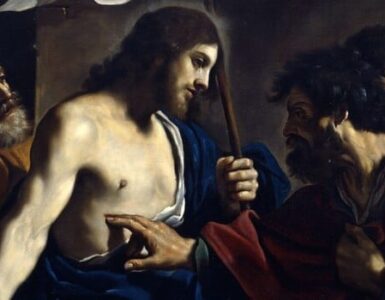The man we have come to know as St. John of the Cross was actually named Juan de Yepes y Alvarez and was born on June 24, 1542, in Old Castile, Spain. His father hailed from a wealthy and noble family, but was disowned by them when he married John’s mother, who was a weaver’s daughter. Therefore, when John was born, it was into poverty. Soon after his birth, John’s father died and the family became homeless.
At age 14, John went to work at a hospital, helping to care for mental patients and others who suffered from incurable illnesses. Through his own poverty and working with these people on a daily basis, John became well acquainted with suffering. However, John was a devout Christian who rejoiced in his sufferings and offered them up to the Lord.
While still working at the hospital, John was able to study at the Jesuit college there. In 1563, he joined the Carmelites at Medina, taking the name of Juan de Santo Matia. He was ordained four years later in 1567. While visiting his home, he met St. Theresa of Avila and expressed to her his desire to join the Carthusian order and delve deeper into a life of solitude and prayer. However, St. Theresa persuaded him to stay with the Carmelites and help her in her efforts to reform the order.
In 1568, taking the name of John of the Cross, John and four other men founded the first men’s house of reform, which was the beginning of the Discalced Carmelites. Unfortunately, there were some who felt threatened by the reform efforts. One night, some of the members of John’s own order kidnapped him and threw him in a tiny cell. Three times a week he was beaten by the monks there in their efforts to get him to abandon his reform efforts. Even in the confines of this small, dark and damp prison, John found joy in God. He used this time to draw even closer to God and deepen his faith.
One day, after nine months of imprisonment, John decided to attempt an escape. Unscrewing the lock on the door to his cell, he climbed out a window using a rope made from torn bedsheets, and lowered himself to the ground. He then followed a dog to find his way into a nearby town. He was able to hide from his pursuers in a convent infirmary where he read his poetry to the nuns.
In 1579, the Discalced Carmelites were recognized and a separate province was founded. John became head of the Discalced College at Baeza; was appointed provincial of Andalusia in 1585; was elected prior at Segovia in 1587; and founded several houses of the order. Later disagreements within the order were brought out into the open, and John lost all his offices because of his support of the moderates. He was then sent, as a simple monk, to the Penuela Monastery in Andalusia. While at this monastery, John contracted a fever and died in 1591.
Lessons
John is now recognized in the Church as one of its greatest mystics. His writings have gained great acclaim as spiritual classics. One of his better-known writings is The Dark Night of the Soul, which was written when he was imprisoned by his brother monks. Saint John was canonized in 1726 and was named a Doctor of the Church by Pope Pius XI in 1926.
From Johnnette Benkovic’s Graceful Living: Meditations to Help You Grow Closer to God Day by Day
Would that men might come at last to see that it is quite impossible to reach the thicket of the riches and wisdom of God except by first entering the thicket of much suffering, in such a way that the soul finds there its consolation and desire. The soul that longs for divine wisdom chooses first, and in truth, to enter the thicket of the Cross.
— St. John of the Cross, Spiritual Canticle
How does St. John’s statement contrast with worldly wisdom? What is my attitude toward the crosses in my life? Can I adjust my perspective and see the great treasure hidden in the suffering and trial?
Prayer
St. John, even when betrayed by some of your own spiritual brothers, you never abandoned your faith. Instead, you drew closer to God and were filled with love, compassion and humility. Pray for us, dear St. John, that we may learn from your great example. Amen.
Other Saints We Remember Today
St. Nicasius, Bishop, and St. Eutropia, his sister (5th Century)
St. Venantius Fortunatus (605), Bishop
image: Arnold van Westerhout, Public domain, via Wikimedia Commons














